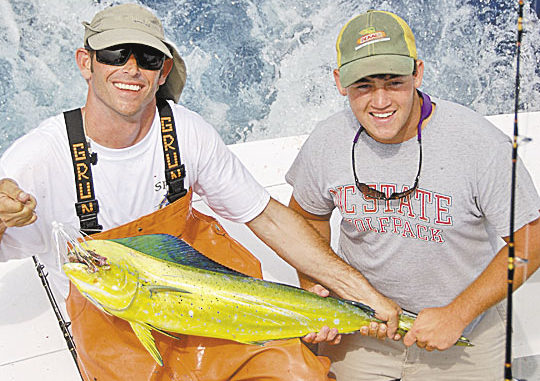
Fall dolphin action out of Oregon Inlet is simply fantastic.
Slipping out of Pirates Cove Marina and heading toward Oregon Inlet, Capt. Harold Smith was steering The Spray, his 61-foot sportfisher, through the pre-dawn darkness toward the bluewater, when the radio crackled.
“Spray?..this is the A-Salt Weapon. Smitty, you out there?”asked Capt. Dennis Ednee, Smith’s friend and dockmate.
“I gotcha Dennis,” Smith replied. “What’s up?”
“Wondering where you were heading this morning,” Endee said. “I think I’m going to head back out to the Point. We had several gaffers yesterday and finished with a limit of bailers. Found them hanging out on a weedline.”
“Yeah, I’m headed that way too,” Smith said. “I’ve got one spot I want to look at first. I’ll give you a shout when we get out there.”
“See you then. A-Salt Weapon out.”
With summer officially winding down, the warm waters of the Gulf Stream will continue to produce good fishing for another six weeks, at least, and as long as it’s warm, there will be plenty of dolphin action to be had.
It’s not uncommon for Smith and other captains to catch a variety of species, including marlin, sailfish, tuna, and wahoo. Dolphin, or mahi-mahi if you prefer, are considered among the top offshore gamefish and are targeted by many anglers. They are famous for their leaps and flips when hooked. Because of their speed and agility, dolphin provide for an exciting catch. They are a warm-water fish usually found in deep water — but close to the surface. Another important characteristic is that dolphin are widely attracted to any type of surface clutter.
“I have caught as many as 20 dolphin hanging around something as small as a crab-pot marker that was floating,” Smith said. “I’m not exactly sure what the attraction is; maybe it’s a point of reference for them or maybe they’re looking for bait around it. One thing for sure is that anything floating in the water will attract dolphin, so that’s a big plus to have around when you’re hoping to catch them.”
Dolphin are voracious predators. While one of their favorite prey is flying fish, they also eat squid, shrimp, crustaceans and even smaller dolphin. With keen eyesight, they locate most food near clumps of floating vegetation and debris objects. They are considered to be the most surface-oriented of all bluewater gamefish.
“Once you get out past 15 fathoms, it’s all about looking for signs of life,” said Smith. “Charterboat captains and their mates have some of the best eyesight of anyone you’ll ever meet. They may not actually see that much better, but they are accustomed to picking out the slightest indications of life on the open ocean — whether that’s a flight of flying fish sailing across the water or the fin of a rolling porpoise — or even just a flat spot in the water that means something is down there.”
One of the most obvious “signs” of life in the offshore waters is commonly referred to as “weeds”. The majority of offshore weeds are Sargasso grass or sargassum, a type of floating brown algae that has a main stem with flattened outgrowths like leaves that contain air sacs to keep the plant afloat. The algae is coated with a sticky substance to help keep the individual plants together in heavy currents. This provides a surface mat and plays host to a wide variety of plant and animal life, creating an ecosystem all to itself.
“You’ll often see dolphin streak out from under the weeds to attack your baits,” Smith said. “That’s why it’s important to troll parallel to the weedlines so you can cover a lot of area and find which ones are holding fish.”
According to Smith, one of the most famous destinations for bluewater trolling is an area referred to as “The Point.” Approximately 35 miles southeast of Oregon Inlet, it is marked on most offshore charts. It is close to the edge of the Continental Shelf and the junction of the southward-flowing Labrador Current and the northward-flowing Gulf Stream.
“It’s a big area, and certain captains have favorite spots located in different places around (it),” Smith said. “Some boats may run 20 miles north of the Point and, others may run 20 miles south — or you can vary east or west by up to five miles and still be in good water. The bottom gets real bumpy out there, and that can influence currents and water temperatures. Temperature breaks — anywhere the water temperature rapidly changes by up to several degrees — are often the key to finding fish. It all comes back to signs of life. You find the bait, and you’ll find fish out there feeding on them.”
One factor that plays in the favor of the angler when it comes to trolling the currents is to motor south of the Point, get upstream of the prevailing current and fish back to the north with the current. Some days, a strong current will make it difficult to gain any ground by trolling against it.
After gaffing a few dolphin in the 8- to 15-pound range, Smith checked in with Endee and found him in the middle of a bailout — the kind that actually helps the Outer Banks economy.
“We were trolling up on a weedline, and the water suddenly turned green and blue,” Endee said. “We immediately backed down and started tossing out bits of cut bonito for chum and casting bailing rigs. We use small Penn Senators paired with Shakespeare Ugly Stiks, 20- to 25-pound class tackle, for bailers. The line has a 6-foot leader with a 2-ounce in-line weight tied between. We throw these chunks of tuna or squid out there, and usually, it’s an immediate hook up.”
“Bailer” dolphin are typically smaller than the “gaffers” — averaging three to five pounds and hanging in schools of up to 50 fish. Two things important to remember when bailing dolphin is to get chum in the water as quickly as possible to get them interested, and once you have one or more fish hooked up, always keep at least one fish in the water at all times.
Dolphin get excited watching the flailing, jumping fight of a hooked fish, and that excitement keeps the rest of the school glued to the spot. If the angling is not coordinated and all the hooked fish are removed from the water, the feeding frenzy may cut off and the school may swim off.
“When we’re bailing dolphin, I try to at least keep the boat in gear so we don’t drift off of them,” Endee said. “But with at least one fish on the line, we can usually keep the whole school right there at the back of the boat. I might just idle around in a big circle to keep them all swimming in the same direction, but so long as there’s food and action, they’ll stay with us. It’s almost like they were waiting in line for their turn to take the hook.”

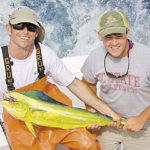
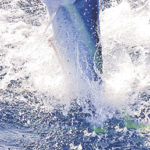
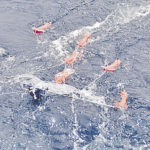
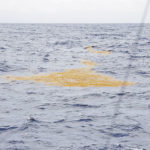
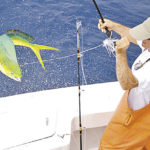
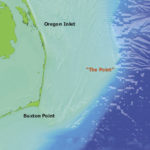



Be the first to comment